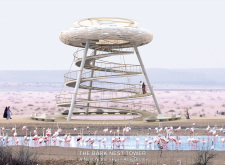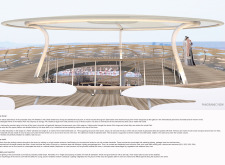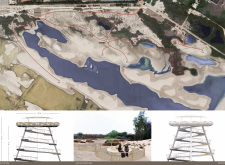5 key facts about this project
The Bark Nest Tower in Abu Dhabi is an observation point designed to connect visitors with the rich landscape of the Al Wathba protected area. The structure stands as a large bird's nest, built atop three columns, and acts as a visual marker in the surrounding environment. Its design not only highlights the natural beauty of the area but also celebrates the theme of ornithology.
Structure and Form
The tower features a prominent nest shape that symbolizes the relationship between architecture and nature. Elevated on three vertical columns, it provides clear views of the surrounding park. This height enhances the visitor experience, allowing for unobstructed sightlines that encourage exploration and appreciation of the landscape. The form of the tower fits well within the natural terrain, offering a modern perspective on organic shapes.
Accessibility and Visitor Experience
Visitors can access the observation area by a wide wooden ramp that promotes a slow and immersive journey to the top. This ramp's design includes shaded areas that protect visitors from the sun, addressing the climatic challenges of the region. Entering through the center of the nest, guests find a communal space designed for interaction and observation, enhancing their connection to the surroundings.
Materiality
The main structural components are made from galvanized steel, which is painted white to resist the local weather conditions. Decorative elements are crafted from 5mm steel sheets that have been cut with precision, reinforcing the concept while maintaining a contemporary look. Solid wood is used for the flooring and handrails because it offers durability and remains cool to the touch in high temperatures. The entire structure is anchored by three concrete bases that are not visible, helping the tower blend into the landscape.
Lighting and Safety Features
Lighting is incorporated along the ramp and within the gazebo to improve safety and create a calm environment during the evening. Handrails meet safety standards and are designed to accommodate visitors with varying needs. The layout of lookout points and resting areas invites exploration and fosters interaction with the diverse wildlife present in the vicinity.
One notable design detail is how light interacts with the tower's surfaces throughout the day. As the sun moves, shadows play across the structure, enhancing the visual experience for visitors and creating a connection between the architectural form and the natural environment surrounding it.






















































